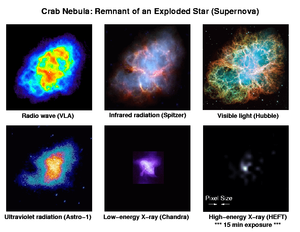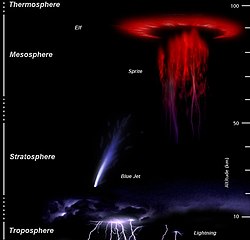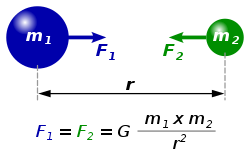Portal:Radiation astronomy

Radiation astronomy is astronomy applied to the various extraterrestrial sources of radiation, especially at night. It is also conducted above the Earth's atmosphere and at locations away from the Earth, by satellites and space probes, as a part of explorational (or exploratory) radiation astronomy.
Seeing the Sun and feeling the warmth of its rays is probably a student's first encounter with an astronomical radiation source. This will happen from a very early age, but a first understanding of the concepts of radiation may occur at a secondary educational level.
Radiation is all around us on top of the Earth's crust, regolith, and soil, where we live. The study of radiation, including radiation astronomy, usually intensifies at the university undergraduate level.
And, generally, radiation becomes hazardous, when a student embarks on graduate study.
Cautionary speculation may be introduced unexpectedly to stimulate the imagination and open a small crack in a few doors that may appear closed at present. As such, this learning resource incorporates some state-of-the-art results from the scholarly literature.
The laboratories of radiation astronomy are limited to the radiation observatories themselves and the computers and other instruments (sometimes off site) used to analyze the results.
Radiation astronomy entities

Radiation astronomy entities, radiation entities, are any astronomical persons or things that have separate and distinct existences in empirical, objective or conceptual reality.
Some of them, like the astronomers of today, or at any time in the past, are relatively known. But there are many entities that are far less known or understood, such as the observers of ancient times who suggested that deities occupied the sky or the heavens. Likewise, these alleged deities may be entities, or perhaps something a whole lot less.
Astronomical X-ray entities are often discriminated further into sources or objects when more information becomes available, including that from other radiation astronomies.
A researcher who turns on an X-ray generator to study the X-ray emissions in a laboratory so as to understand an apparent astronomical X-ray source is an astronomical X-ray entity. So is one who writes an article about such efforts or a computer simulation to possibly represent such a source.
"The X-ray luminosity of the dominant group [an entity] is an order of magnitude fainter than that of the X-ray jet."[1]
References
- ↑ A. Finoguenov, M.G. Watson, M. Tanaka, C.Simpson, M. Cirasuolo, J.S. Dunlop, J.A. Peacock, D. Farrah, M. Akiyama, Y. Ueda, V. Smolčič, G. Stewart, S. Rawlings, C.vanBreukelen, O. Almaini, L.Clewley, D.G. Bonfield, M.J. Jarvis, J.M. Barr, S. Foucaud, R.J. McLure, K. Sekiguchi, E. Egami (April 2010). "X-ray groups and clusters of galaxies in the Subaru-XMM Deep Field". Monthly Notices of the Royal Astronomical Society 403 (4): 2063-76. doi:10.1111/j.1365-2966.2010.16256.x. http://onlinelibrary.wiley.com/doi/10.1111/j.1365-2966.2010.16256.x/full. Retrieved 2011-12-09.
Cosmogony

Cosmogony is any scientific theory concerning the coming into existence, or origin, of the cosmos or universe, or about how what sentient beings perceive as "reality" came to be.
Usually, the philosophy of cause and effect needs a beginning, a first cause. Modal logic may only require a probability rather than a sequence of events. The concept of uncountable suggests an unknown somewhere between a finite number of likely rationales and an infinite number of possibilities.
From a sense of time as moving forward from yesterday to today and onward to tomorrow, there is again a suggestion of a prehistoric time before the first hominins.
The use of any system of thought or emotion to perceive reality suggests that some existences may precede others.
When more detail becomes available an existence may be transformed into something, an entity, a source, an object, a rocky object, or out of existence.
As a topic in astronomy, cosmogony deals with the origin of each astronomical entity.
Observation, for example, using radiation astronomy may provide some details.
Theoretical astronomy may provide some understanding, or at least some perspective.
In astronomy, cosmogony refers to the study of the origin of particular astrophysical objects or systems, and is most commonly used in reference to the origin of the solar system.[1][2]
References
Backgrounds

In the figure at right, CUVOB stands for the cosmic ultraviolet and optical background.
The diffuse extragalactic background light (EBL) is all the accumulated radiation in the Universe due to star formation processes, plus a contribution from active galactic nuclei (AGNs). This radiation covers the wavelength range between ~ 0.1-1000 microns (these are the ultraviolet, optical, and infrared regions of the electromagnetic spectrum). The EBL is part of the diffuse extragalactic background radiation (DEBRA), which by definition covers the overall electromagnetic spectrum. After the cosmic microwave background, the EBL produces the second-most energetic diffuse background, thus being essential for understanding the full energy balance of the universe.

With no strong central nuclear energy source, the interior of a brown dwarf is in a rapid boiling, or convective state. When combined with the rapid rotation that most brown dwarfs exhibit, convection sets up conditions for the development of a strong, tangled magnetic field near the surface. The flare observed by Chandra X-ray Observatory from LP 944-20 could have its origin in the turbulent magnetized hot material beneath the brown dwarf's surface. A sub-surface flare could conduct heat to the atmosphere, allowing electric currents to flow and produce an X-ray flare, like a stroke of lightning. The absence of X-rays from LP 944-20 during the non flaring period is also a significant result. It sets the lowest observational limit on steady X-ray power produced by a brown dwarf star, and shows that coronas cease to exist as the surface temperature of a brown dwarf cools below about 2500°C and becomes electrically neutral.
This is a composite image (X-ray - red, optical - blue & white) of the spiral galaxy M74 with an ultraluminous X-ray source (ULX) indicated inside the box. Image is 9 arcmin per side at RA 01h 36m 41.70s Dec +15° 46' 59.0" in Pisces. Observation dates: June 19, 2001; October 19, 2001. Aka: NGC 628, ULX: CXOU J013651.1+154547. Credit: X-ray; J. Liu (U.Mich.) et al., CXC, NASA - Optical; Todd Boroson/NOAO/AURA/NSF.{{Fair use}}
First microwave source in Cepheus
The first microwave source in Cepheus is unknown.
The field of microwave astronomy is the result of observations and theories about microwave sources detected in the sky above.
The first astronomical microwave source discovered may have been the Sun.
But, microwaves from the Sun are intermingled with other radiation so that the Sun may appear as other than a primary source for microwaves.
The early use of sounding rockets and balloons to carry microwave detectors high enough may have detected microwaves from the Sun as early as the 1940s.
This is a lesson in map reading, coordinate matching, and researching. It is also a research project in the history of microwave astronomy looking for the first astronomical microwave source discovered in the constellation of Cepheus.
Nearly all the background you need to participate and learn by doing you've probably already been introduced to at a secondary level and perhaps even a primary education level.
Some of the material and information is at the college or university level, and as you progress in finding microwave sources, you'll run into concepts and experimental tests that are actual research.
If stellar flares have origins similar to solar flares, then flare stars produce microwaves.
Electron astronomy quiz

Electron astronomy is a lecture as part of the radiation astronomy course on the principles of radiation astronomy.
You are free to take this quiz based on electron astronomy at any time.
To improve your score, read and study the lecture, the links contained within, listed under See also, External links, and in the {{principles of radiation astronomy}} template. This should give you adequate background to get 100 %.
As a "learning by doing" resource, this quiz helps you to assess your knowledge and understanding of the information, and it is a quiz you may take over and over as a learning resource to improve your knowledge, understanding, test-taking skills, and your score.
Suggestion: Have the lecture available in a separate window.
To master the information and use only your memory while taking the quiz, try rewriting the information from more familiar points of view, or be creative with association.
Enjoy learning by doing!
Cratering astronomy laboratory
This laboratory is an activity for you to create or analyze a cratering. While it is part of the astronomy course principles of radiation astronomy, it is also independent.
Some suggested types of cratering to consider include a lightning strike, a bullet shot into some material, a water droplet hitting the surface of a beaker of water, a subterranean explosion, a sand vortex, or a meteorite impact.
More importantly, there is your cratering idea. And, yes, you can crater a peanut butter and jelly sandwich if you wish to.
Okay, this is an astronomy cratering laboratory, but you may create what a crater is. Another example is a volcanic crater.
I will provide an example of a cratering experiment. The rest is up to you.
Please put any questions you may have, and your laboratory results, you'd like evaluated, on the laboratory's discussion page.
Enjoy learning by doing!
Energy phantoms

Students start from specific situations of motion, determine how to calculate energy and convert units, then evaluate types of energy.
Def. a quantity that denotes the ability to do work and is measured in a unit dimensioned in mass × distance²/time² (ML²/T²) or the equivalent is called energy.
Def. a physical quantity that denotes ability to push, pull, twist or accelerate a body which is measured in a unit dimensioned in mass × distance/time² (ML/T²): SI: newton (N); CGS: dyne (dyn) is called force.
In astronomy we estimate distances and times when and where possible to obtain forces and energy.
The key values to determine in both force and energy are (L/T²) and (L²/T²). Force (F) x distance (L) = energy (E), L/T² x L = L²/T². Force and energy are related to distance and time using proportionality constants.
Every point mass attracts every single other point mass by a force pointing along the line intersecting both points. The force is proportional to the product of the two masses and inversely proportional to the square of the distance between them:[1] - ,
where:
- F is the force between the masses,
- G is the gravitational constant,
- m1 is the first mass,
- m2 is the second mass, and
- r is the distance between the centers of the masses.

The diagram shows two masses attracting one another. Credit: Dna-Dennis.
In the International System of Units (SI) units, F is measured in newtons (N), m1 and m2 in kilograms (kg), r in meters (m), and the constant G is approximately equal to 6.674×10−11
N m2 kg−2.[2]
Observationally, we may not know the origin of the force.
Coulomb's law states that the electrostatic force experienced by a charge, at position , in the vicinity of another charge, at position , in vacuum is equal to:
where is the electric constant and is the distance between the two charges.
Coulomb's constant is
where the constant is called the permittivity of free space in SI units of C2 m−2 N−1.
For reality, is the relative (dimensionless) permittivity of the substance in which the charges may exist.
The energy for this system is
where is the displacement.
References
- ↑ - Proposition 75, Theorem 35: p.956 - I.Bernard Cohen and Anne Whitman, translators: Isaac Newton, The Principia: Mathematical Principles of Natural Philosophy. Preceded by A Guide to Newton's Principia, by I. Bernard Cohen. University of California Press 1999 ISBN 0-520-08816-6 ISBN 0-520-08817-4
- ↑ CODATA2006. http://www.physics.nist.gov/cgi-bin/cuu/Value?bg.

Infrared images from NASA's Spitzer Space Telescope and Wide-field Infrared Survey Explorer (WISE) are combined in this image of RCW 86, the dusty remains of the oldest documented example of an exploding star, or supernova. The infrared images, when combined with optical and X-ray data, clearly indicate that the source of the mysterious object seen in the sky over 1,800 years ago must have been a Type Ia supernova. On Wikiversity is a fair use image of RCW86 that combines an X-ray image from Chandra and XMM-Newton of RCW 86. Low energy X-rays are in red, medium energies in green, and high energies in blue. RCW 86 was created by a star that exploded about 2,000 years ago. RA 14h 45m 02.30s Dec Template:Dec, observation date: June 15, 2004. Credit: Chandra: NASA/CXC/Univ. of Utrecht/J.Vink et al. XMM-Newton: ESA/Univ. of Utrecht/J.Vink et al.
Fields associated with radiation astronomy include Astronomy, Astrogeology, Astrognosy, Astrohistory, Astrophysics, Atmospheric sciences, Charge ontology, Chemistry, Cosmogony, Fringe sciences, Geochemistry, Geochronology, Geology, Geomorphology, Geophysics, Geoseismology, Hydromorphology, Lofting technology, Mathematics, Measurements, Mining geology, Nuclear physics, Oceanography, Petrophysics, Radiation physics, Shielding, Spaceflights, Structural geology, Technology, Trigonometric-parallax astronomy, and X-ray trigonometric parallax
Other Wikiversity science-related portals: Anthropology - Archaeology - Astronomy - Biology - Biochemistry - Chemistry - Ecology - Fluid mechanics - Genetics - Hematology - Immunology - Life sciences - Materials science and engineering - Neurology - Organic chemistry - Particle physics - Quantum biology - Regional anatomy - Sciences - Technology
|
Wikiversity's sister projects
Wikiversity is hosted by the Wikimedia Foundation, a non-profit organization that also hosts a range of other multilingual and free-content projects: Wikipedia
Free-content encyclopedia Wikibooks
Free textbooks and manuals Commons
Shared media repository Incubator
Wikimedia incubator Wiktionary
Dictionary and thesaurus Wikiquote
Collection of quotations Wikinews
Free-content news Betawikiversity
Betawikiversity project Wikispecies
Directory of species Wikisource
Free-content library Wikivoyage
Open travel guide Phabricator
MediaWiki bug tracker Meta-Wiki
Wikimedia project coordination MediaWiki
Free software development Wikidata
Free knowledge base Wikimedia Labs
MediaWiki development Wikiversity is also available in other languages: |
Content by Subject
Arts ·
Humanities ·
Mathematics ·
Medicine ·
Science ·
Social Sciences ·
Technology
Content by Level
Pre-school Education ·
Primary Education ·
Secondary Education ·
Tertiary Education ·
Non-formal Education ·
Research






























